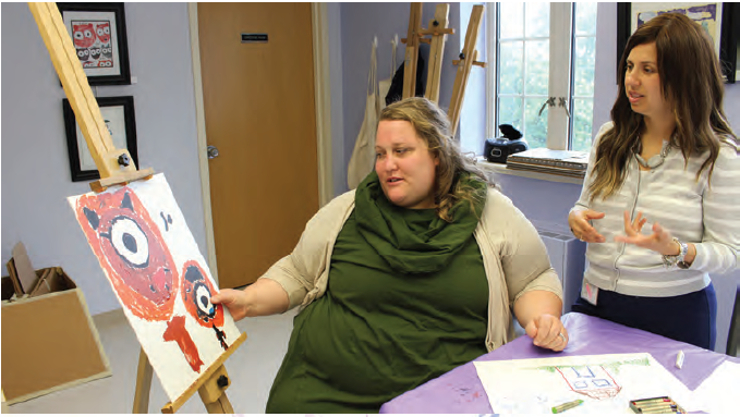Caldwell University
September 7, 2017
Art Therapy- Hands On Experience in Healing Profession

Mental health counseling and art therapy graduate student Jessica Hauck has seen the pain children experience when they lose a parent or close loved one. At her internship site, the Journeys program at Valley Hospital, she has worked in individual, group and family sessions. “Grief can be overwhelming and difficult to process, especially for children and adolescents. The most rewarding thing about my work is when I can help facilitate communication that might not otherwise have taken place,” Hauck says. The hope is that the art therapy will help the healing process. “Regardless of the population, it is another mode of communication. The art therapy process makes it easier to talk when one’s hands are moving or to never talk, whichever the client chooses,” she explains. At Valley, Hauck worked under the supervision of art therapist Laura V. Loumeau-May, ATR-BC, LPC, who is an adjunct art therapy faculty member at Caldwell. “I loved being a fly on the wall when Laura was working with clients,” says Hauck.
Loumeau-May says Journeys has had some of the best in Caldwell interns. “The relationship is really mutual; they enrich our program and in turn, Journeys has a lot to offer the interns.”
Caldwell students can intern in different sites and settings with various populations. They complete a total of 800 hours in internship and take part in the art therapy day of service. They could be exposed to any number of experiences such as bereavement, oncology, psychiatry, dementia, nursing, substance abuse and addiction, trauma, special needs, and court-mandated psychiatric rehabilitation. “This allows students to learn to make adaptions to their approach and know that art therapy works with a range of people,” says Annette Vaccaro, LCSW, ATR-BC, art therapy faculty and clinical coordinator for the mental health counseling with art therapy master’s degree program. The experience prepares students for the workforce. “Art therapists are creative and learn to respond and solve problems when faced with a complexity of abilities, resources and materials,” says Vaccaro.
Graduate student Jolene Stark interned with Atlantic Health System and was introduced to a number of areas at Morristown Medical Center including pediatrics, oncology, delirium prevention and the healing arts program’s Creative Open Studio, a walk-in program. “The wide range of experiences and working with multiple populations have helped prepare me to be a well-rounded counselor and art therapist,” says Stark.
Atlantic Health System provides Caldwell interns with the opportunity to work in its other programs that have art therapy including in-patient and outpatient behavioral health, pediatrics, the delirium prevention program, and this fall semester, a new area for interns, palliative care, at Overlook Medical Center.
Caldwell students come to the program “extraordinarily prepared,” says Deborah Douek, coordinator of the program at Atlantic Health System. She supervises Caldwell’s interns administratively and clinically. “We value the relationship they bring to Atlantic Health System…it is a symbiotic relationship; they learn a lot here and have the opportunity to explore a variety of patient care areas.”
Douek was thrilled to hire two Caldwell graduates after they completed their studies. Alexis Mardosa works in the Newton Medical Center Emergency Department and Caitlyn Stichter works in the Goryeb Children’s Hospital Inpatient Unit and Creative Open Studio.
Besides their internships, some graduate students work with faculty on research, allowing them to present at conferences, to network with professionals and to have their work published. Hauck worked on research projects with the guidance of Dr. Thomson Ling, associate professor and associate dean of the Division of Psychology and Counseling. One outstanding work that she and Ling produced was an ethical decision-making model for art therapists. Their manuscript, “The DO ART Model: An ethical decision-making model applicable to art therapy,” was published in Art Therapy: Journal of the American Art Therapy Association. They presented their work along with art therapy student Melanie Peters at the American Art Therapy Association’s annual conference in Baltimore in 2016. For Hauck and Stark the art therapy program met every expectation. “All I do is talk about this program. My family teases me. My professors are amazing,” says Hauck.
Stark appreciates the diversity of experiences she had at Caldwell. “The program allowed me to explore so much of what brought me to want to be a therapist, as well as the clinical training to be an effective counselor.” She is interested in working with veterans in the future, especially since her father has a military background. “Veterans make a great sacrifice. I feel very connected to this population.” Art therapy gives veterans a chance to communicate about the traumas they may not have been able to verbalize, she says.
Caldwell art therapy graduate students have a dual benefit of receiving training in counseling and in art therapy. They receive an M.A. in Mental Health Counseling with an Art Therapy Specialization, which is accredited by the Council for Accreditation of Counseling and Related Educational Programs (CACREP) and fulfills coursework requirements for licensure in New Jersey as a professional counselor and CACREP standards for clinical mental health counselors. The program is also approved by the American Art Therapy Association and fulfills coursework requirements for registration as an art therapist with AATA and licensure as a professional art therapist in New Jersey.
Having the counseling and the art therapy pieces gives graduates an advantage and more opportunity in the field, says Stark. “I saw the benefit of having the dual study in my various internship experiences.”





